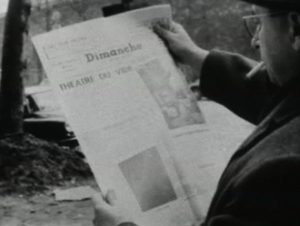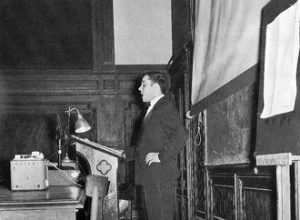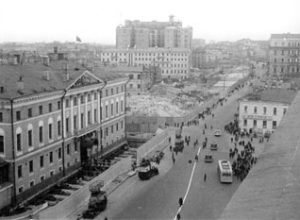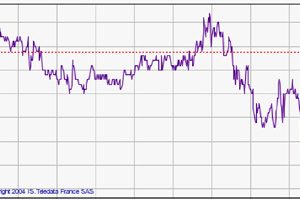
It is difficult to talk about Yves Klein free from the cult surrounding him. That, however, is what three observers who are attentive of this “salesman of the void”’s connections with economic issues have tried to do. Klein had received this epithet in 1960 from a Tribune de Lausanne journalist who failed to see to what extent Klein thought instead in terms of the “plenum.” In reintroducing the medieval notion of the “just price,” the artist was not just playing at the role of a scholar. He was taking charge of the economic system surrounding his work, with a desire to control all its terms as well as everything else.
Laurence Bertrand Dorléac
Yves Klein:
Credit via
the Market
Denys Riout
Besides the monochrome pictures, the anthropometries, the fire paintings, and many other projects that pertain to the realm of the visible, Yves Klein executed, exhibited, and sold some “invisible” works. I would like to show that these sales pertain to a strategy that was designed to establish their credibility, the principle of which is simple: since they are offered on the art market and since they find buyers, these impalpable creations fully exist and really do possess the status of art works in their own right.
Nonetheless, to the extent that they are not works like others, since they are not consubstantially tied to the support of an artefact–like a painting–or an object–like a readymade–the condition for their sale as well as their payment are governed by modalities the artist perfected in order to manifest his uniqueness
Invisible Pictorial Sensibility and Its Value
Klein was following in the footsteps of his predecessors when he published two collections of plates that supposedly were reproductions of his monochromes. The captions for those brought together in Yves Peintures (1954) mention in particular some of the cities in which the artist resided: Nice, Paris, London, Madrid, and Tokyo. The implicit message is clear. In 1954, Klein had already been painting monochrome pictures for several years; his stature was international, and his works were well enough known to occasion a series of reproductions. In fact, Klein turns the traditional logical order on its head. Monographs, even modest ones, serve to confirm someone’s already established success, whereas he published these collections before having exhibited anything at all. It no less remains the case that the novice artist was using time-tested means for increasing his prestige. He continued along this path with Haguenault Peintures (1954), a companion work to the previous one, several captions of which leaned on the alleged inclusion of his monochromes in private collections in order to reinforce the impression that they belonged to the world of art.
Klein innovated during the first show from his “blue period,” Poposte monocrome: Epoca blu (Milan, Apollinaire Gallery, January 1957), or more exactly with the retrospective presentation he offered of it shortly after the show closed. At the time of the opening, eleven pictures, all of the same size and texture and covered in the same ultramarine blue, were offered at the same price–25,000 lire. When the artist stated that he had posted varying prices, he was constructing a didactic fable based on the intricate connections between financial value and artistic value. Klein wished to impose the idea that the picture’s substantial quality resided in its “pictorial sensibility,” which is, by its essence, invisible yet capable of forcefully affecting collectors. The most attentive among them were indeed able, according to the artist, to discern the singularity of each of his “monochrome propositions” put on sale at different prices, and this in contradiction to the then-widespread practice of pricing a picture as a function of its size. Klein exultantly stated: “This fact proves, for one thing, that the pictorial quality of each picture was perceptible through something other than the material physical appearance, and for another, that those who made selections were obviously cognizant of that state of things that I call ‘Pictorial Sensibility.’”[ref]Yves Klein, “L’aventure monochrome,” Part 1, “Le vrai devient réalité ou Pourquoi pas?”, reprinted in: Yves Klein, Le Dépassement de la problématique de l’art et autres écrits [hereafter: Écrits], Marie-Anne Sichère and Didier Semin, eds (Paris: École Nationale Supérieure des Beaux-Arts, 2003, p. 233, and translated in Yves Klein, 1928-1962: Selected Writings, trans. Barbara Wright ([London]: Tate Gallery, 1974), p. 105.[/ref] Support from collectors, or at least from some of them, is crucial to the success of this artistic project. Agreement about the modes of commercial exchange is equivalent here to agreement about what is exchanged. What remained to be done was to go from the mode of the speculative imagination to that of the art market properly speaking.
Exhibiting Immaterial Pictorial Sensibility
It is possible that the substantial quality of the blue monochromes resides in the radiation of invisible pictorial sensibility with which they would in varying ways be laden. Everyone nevertheless remains free not to believe anything of that and to appreciate these perfectly visible pictures for other reasons. To make his demonstration more convincing, Klein therefore decided to present this “sensibility” in a way that would be free of any support. Before proceeding to the picture’s spectacular “immaterialization,” he began by discreetly testing the reactions of indulgent visitors, whether friends or art critics. He seized the occasion of his exhibition at the Colette Allendy Gallery (Paris, May 1957) to arrange blue works on the ground floor and, on the upper floor, “surfaces and blocks of pictorial sensibility.”
Few visitors went up the stairs, but a filmed report of the exhibition shows the artist upstairs, in an empty room, inviting us, with an appropriate gesture, to perceive the “presence” of invisible pictures. And an article penned by J. A. (Julien Alvard), which appeared in the review Cimaise (July-August1957), makes mention of this “bright room with no pictures” whose “receptive walls reveal the presence of blue without any support.” After the discreet success of this trial effort, Klein decided to offer a vivid incandescence to the presentation of “immaterial pictorial sensibility,” preparing an exhibition that had no title at the time of its opening, but which he later named “The Specialization of Sensibility in the Raw Material State into Stabilized Pictorial Sensibility” before it was handed down to posterity under the deceptive exhibition title “The Void” (Paris, Iris Clert Gallery, April 1958).
Nothing tangible was exhibited there; nothing was to be sold. But the artist, intent on keeping visitors from stealing from him some “shreds” of pictorial sensibility, attached to the invitation card for the exhibition opening “a kind of free-admission ticket stating that without that special little card the price of admission will be 1,500 francs per person.” Those persons who did not have one were expected to pay this sum (the equivalent of about 25 euros today) to enter the gallery. In his account of the opening, the artist did not fail to note that “certain persons, furious at having paid 1,500 francs admission to see nothing with their own eyes inside, have been to lodge complaints.” [ref]Yves Klein, Le Dépassement de la problématique de l’art, La Louvière, Éditions Montbliart, 1959, p. 11 (Écrits, op. cit., p. 92).[/ref]
Klein later announced that he had sold two immaterial works during this show.[ref]Ibid., p. 12 (Écrits, p. 94).[/ref] Yet no plans had been made to arrange for such sales, even though the question had been preoccupying the artist for several months. The group show in which he participated in March 1959, Vision in Motion–Motion in Vision (Antwerp, Hessenhuis) offered him the occasion to give a first formulation of the modalities for such sales.
The Gold Value of Immaterial Pictorial Sensibility
Klein showed nothing tangible in the exhibition hall. Also, on the evening of the opening, when the event organizer asked him where his work was, his answer was: “There, there where I am speaking at this moment.” The dialogue continued. “And what is the price of this work?” “A kilo of gold, a kilo of gold ingot will suffice me.”[ref]Yves Klein, “L’évolution de l’art vers l’immatériel,” lecture given at the Sorbonne, June 3, 1959 (Écrits., p. 121). A recording of this lecture transferred to an audio CD accompanies Yves Klein, Vers l’immatériel . . ; see p. 118.[/ref] This requirement sealed his association between immateriality and gold. The artist quite deliberately decreed some conditions that he himself deemed “fanciful,” instead of proposing quite simply “a normal price simply represented by a sum of money,” for that in no way suited the value of “pictorial sensibility in raw material state.”[ref]Ibid. (Écrits, p. 122), translated in Vers l’immatériel . . . , p. 118.[/ref]
Like immaterial works, gold is inalterable. Moreover, it remains, at least mythically, the benchmark monetary standard, whereas pictorial sensibility represents, par excellence, the value of the picture and, by extension, every work of art. The Pinay bonds launched in 1958, which were indexed to gold and exempted from estate taxes, had revived the credit granted to this ever so fascinating metal at the time when Klein was having recourse to it. By himself indexing his most questionable works to gold, the artist incorporated into them a “capital trust.” What remained to be done was to formalize both the works that were transferable and the modalities for their acquisition.
At the end of 1959, Klein completed work on the receipts meant to authenticate the transfer of “zones of immaterial pictorial sensibility.” These receipts were bound together in small books that looked like “checkbooks,” a term that was immediately adopted and took hold in a way that was as recurrent as it was faulty, including among the artist’s close associates. The logic of the gold standard and that of the check were, however, far from equivalent.
The first four buyers (in December 1959) retained their receipts. Some were framed, which ran the risk of confusion, since the work is not the document attesting to its sale. To overcome this abuse, Klein developed the “Ritual Rules for the Transfer of Zones of Immaterial Pictorial Space.”[ref]The full text of these “Règles rituelles”is reprinted in Yves Klein, Écrits, pp. 278-79, and translated as “Ritual for the Relinquishment of the Immaterial Pictorial Sensitivity Zones,” in Theories and Documents of Contemporary Art: A Sourcebook of Artists’ Writings, Kristine Stiles and Peter Selz, eds (Berkeley: University of California Press, 1996), p. 81.[/ref] These rules stipulated that the buyer would be denied the “authentic immaterial value of the work” if he retained the receipt. He had to burn it in the presence of witnesses in order that “the fundamental immaterial value of the zone belong to him and become a part of him.” And as for the artist himself, he then returned to nature half of the gold received. Three full transfers (to Claude Pascal, Dino Buzzati, and Michael Blankfort), with destruction of the receipt by fire, were carried out (February 1962). This fact is decisive, for the “zones of immaterial pictorial sensibility” would have remained fictions had no buyer given them some proof of real commercial existence, a sign and guarantee of artistic existence.
Klein retained six small bars of gold, which undoubtedly came from the transfer granted to Michael Blankfort. Anonymously, he also deposited at the monastery in Cascia, where the body of Rita, patron saint of lost causes, is preserved, a votive offering that was discovered and authenticated in 1979. This box in transparent plexiglass contains some blue pigment, pink pigment, gold leaf, a prayer addressed to the saint, and three bars of fine gold, “proceeds from the sale of the first four zones of immaterial pictorial sensibility.”[ref]Yves Klein, “Prière à sainte Rita” (February 1961), Écrits, pp. 276-77.[/ref] Here, we are quite far from avant-garde jokes and funny phrases, quite far, too, from commercialism, and closest to the “marvellousness” for which the artist continued to pray with all his might, and upon which a judicious use of the art market helps to confer an aura of authentic concreteness.
bibliography
Klein, Yves. Le Dépassement de la problématique de l’art et autres écrits. Eds. Marie-Anne Sichère and Didier Semin. Paris: École Nationale Supérieure des Beaux-Arts, 2003.
_____. “Ritual for the Relinquishment of the Immaterial Pictorial Sensitivity Zones.” In Theories and Documents of Contemporary Art: A Sourcebook of Artists’ Writings. Kristine Stiles and Peter Selz. Eds. Berkeley: University of California Press, 1996.
_____. Vers l’immatériel/Towards the Immaterial: Le dépassement de la problématique de l’art/Beyond the problematic of Art, La conférence en Sorbonne/The Sorbonne Talk. Preface Denys Riout. Bilingual Text. Trans. Charles Penwarden, avec un CD, reproduction de La conférence en Sorbonne/with a CD, a reproduction of the recording of The Sorbonne Talk. Paris: Dilecta, 2006.
_____. Yves Klein, 1928-1962: Selected Writings. Trans. Barbara Wright. [London]: Tate Gallery, 1974.
Stich, Sidra. Yves Klein. Stuttgart: Cantz Verlag, 1994. (Work published on the occasion of the Yves Klein exhibitions at the Museum Ludwig, Cologne, and the Kunstsammlung Nordrhein-Westfalen, Düsseldorf, November 8, 1994 – January 8, 1995; the Hayward Gallery, London, February 9 – April 23, 1995; and the Museo Nacional Centro de Arte Reina Sofia, Madrid, May 24 – August 29, 1995.)
Yves Klein, 1928-1962: A Retrospective. Catalogue of the eponymous exhibition at the Rice Museum, Houston, the Museum of Contemporary Art, Chicago, the Salomon R. Guggenheim, New York, and the Centre Pompidou, Paris. Houston: Institute for the Arts, Rice University, in association with The Arts Publisher (New York), 1982.
Yves Klein. Catalogue of the eponymous exhibition. Paris: Centre Pompidou/Musée national d’art moderne, 1983.
Yves Klein. Corps, couleur, immatériel. Catalogue of the eponymous exhibition at the Centre Pompidou, Paris, October 5, 2006 – February 5, 2007 and the Museum Moderner Kunst Stiftung Ludwig, Vienna, March 9 – June 3, 2007. Paris: Centre Pompidou, 2006. (A different version of this catalogue was published for the Vienna exhibition. Yves Klein. Die blaue Revolution. Vienna: Springer, 2007.)
Yves Klein: With the Void, Full Powers. Catalogue of the eponymous exhibition at the Hirshhorn Museum and Sculpture Garden, Washington, D.C., May 20 – September 12, 2010, and the Walker Art Center, Minneapolis, October 23, 2010 – February, 13, 2011. Washington, D.C.: Hirshhorn Museum and Sculpture Garden and Minneapolis: Walker Art Center, 2010.
Riout, Denys. Yves Klein: Manifester l’immatériel. Paris: Éditions Gallimard, 2004. Yves Klein: Expressing the Immaterial. Trans. Chrisoula Petridis. Paris: Éditions Dilecta, 2010.
Denys Riout is a professor emeritus in the history of modern and contemporary art at the University of Paris-I (Pantheon-Sorbonne). He has published: Qu’est-ce que l’art moderne? (Paris: Gallimard, 2000, 2009);Yves Klein, Manifester l’immatériel (Paris, Gallimard, 2004); La Peinture monochrome. Histoire et archéologie d’un genre, rev. and expanded ed. (Paris, Gallimard, 2006); and Yves Klein. L’aventure monochrome (Paris: Gallimard, 2006). He is currently finishing up writing a work on “invisible works.”




